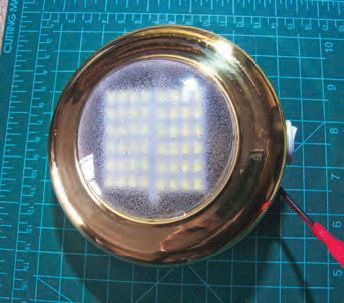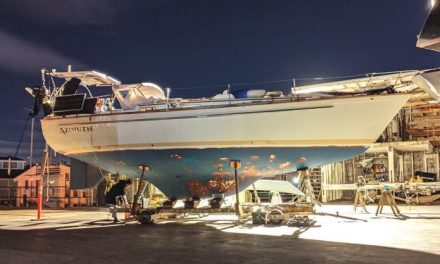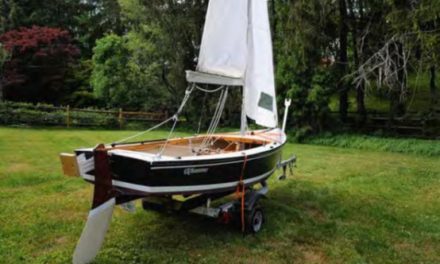Replacing a boat’s halogen lights with LED ones is a satisfying, power-saving upgrade at a minimal cost
Issue 150: May/June 2023
During long Quebec winters, while my small sailboat is covered on the hard and waiting for the next sailing season, I often amuse myself with various small boat-related projects.
A few winters ago, I decided to replace my halogen boat lights and go full LED. The first phase was to modify the cabin lights, which were traditional brass dome lights with halogen bulbs. My sailboat has a simple electrical installation and only one battery. I try to avoid unnecessary power drains whenever I can, so I often rely on my oil lamp on cooler evenings. By replacing halogen bulbs with LED ones, I hoped to further reduce my power consumption aboard.
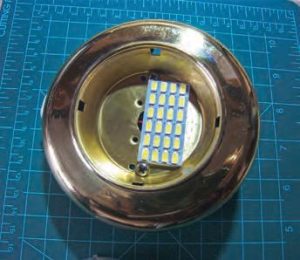
A single LED array sits inside the brass housing for one of the boat’s cabin lights.
An online search of chandleries showed that LED bulbs were readily available for the G4 sockets I had in my cabin lights. But prices of more than $40 Canadian per bulb prompted me to look for a more affordable option. LED lights are now less expensive, but even recently I’ve seen some costing around $20 CAD at my local chandlery. After some more online searching, I ordered a few different types of LED array lights from eBay, along with some small heat sinks and a bag of assembled LED drivers. LED lights must operate at a certain voltage, and if subjected to higher voltage than they’re designed for, they will overheat and burn out. An LED driver is a small electrical device/circuit used to regulate power to the lights.
To explain this a little further, the voltage an LED light requires to conduct electricity and light up is called “forward voltage.” As the temperature of the LED light increases, the forward voltage (volts) will decrease and the light will draw more current (amps). That will result in the light getting hotter and again drawing more current, repeating that until it burns itself out. This is called “thermal runaway.”
To avoid that, LED drivers are used to provide a constant current to the lights and compensate for the changes in the forward voltage. There are many types of LED drivers available; some of them include a self-contained power supply.
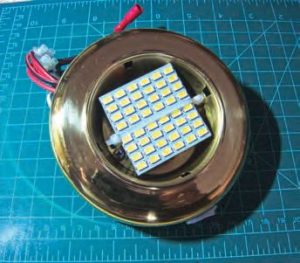
Two LED arrays inside the light housing are held in place with tie wrap.
The LED arrays I purchased were designed to run on 12 volts, and the accompanying documentation did not mention a requirement to use a LED driver. Nonetheless, I tested a few of them by leaving them on for up to 48 hours, using a car battery as the source of unregulated 12-volt power. They did not burn out, but they were running so hot I couldn’t touch them. After connecting the LED driver between the LED array and the battery, the loss of light output was negligible, but they were not getting so hot anymore; I could hold my finger on them without getting burned.
I removed the three cabin lights, and after taking off the lenses, I was able to unscrew the G4 sockets and remove them. I left the original switch in place and crimped a bullet connector to the end of the wire I had to cut. I mounted the LED array directly on the light housing under the lens, using double-sided tape. The light housing acts as a heat sink for the LED array. I connected the pins of the LED driver with 12-volt power wires, using small screw-type terminal connectors, and soldered connections between the LED arrays and drivers.

The author installed two LED arrays in one of the cabin lights.
I used heat-shrink tubing where needed, and also over the LED driver to isolate it from the brass housing. When installing LED lights, it’s critical to pay attention to polarity (positive/negative) because the LED array must be connected properly, otherwise the lights will not work. The same applies for LED drivers.
In one of the cabin lights, I installed two LED arrays. I was concerned about heat dissipation, so I used a small heat sink under the arrays. Luckily, there was enough room under the lens to mount everything. Each of the two LED arrays was connected to a dedicated LED driver, as the drivers I purchased could only handle a maximum of 3 watts of power each.
The project was interesting and occupied me for some time. One can argue that purchasing G4–compatible LED bulbs and installing them would certainly be much faster and easier. However, I believe this was a much more satisfying way to upgrade my cabin lights. As another benefit, the cost of doing it was minimal. These days, you can get a small heat sink for less than $1 and 10 LED drivers for less than $7, and prices for small LED arrays start at less than $3. Another option would be to use LED 12-volt light strips instead of arrays. The strips can be cut to shorter sections and installed in a similar type of light housing as described here.
Based on my measurements (see “Some Numbers” below), the LED cabin lights use four times less power than halogen bulbs. The amount of light in my cabin has increased while power consumption is reduced. The only complaint I have is the light color; I find most LED bulbs emit too cool of a white light, but that is really a question of taste, I guess. You can also get red LED bulbs, which are useful for night vision lighting.
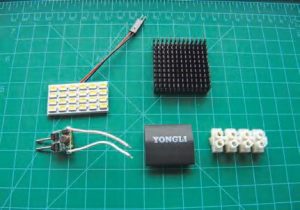
Components for the project included LED arrays, LED drivers, heat sinks, heat-shrink tubing, and screw-type connectors.
Some Numbers
There are many different SMD (surface-mount device) LED chips used to make LED bulbs, and when I worked on this project the most popular were SMD 5630, 5730, and 5050. SMD means that the LEDs are mounted directly to some kind of surface without using wires. These chips differ in their characteristics, but for a non-critical application (such as replacing a boat’s cabin lights) those differences will not be visible in most cases, although the light output could vary.
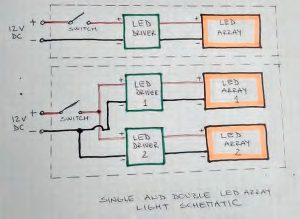
A drawing maps out the light replacement project.
The typical output of a low-voltage halogen bulb is around 24 lumens per watt. Each of the 10-watt bulbs I replaced provided about 240 lumens of light output. In theory, at 12 volts, that 10-watt bulb should draw 0.83 amps from the boat house battery. For only one light this is not much, but even a small boat would most likely have more than one light in the cabin, and the battery power drain created by these lights should not be ignored. I replaced my halogen bulbs with LED arrays made from 24 SMD 5730 LED chips. The light output of each array was specified as 480 lumens and 2.9 watts of power. So theoretically, the current draw for one array should be 0.24 amps.
I verified the current draws, and the halogen bulb was right on spec with 0.83 amps. The LED arrays were doing a bit better than noted in the specification sheet, drawing only 0.20 amps each. Most likely the SMD chips used to build these arrays were not up to their exact specs, probably being less powerful and emitting less light. Since there are different generations of the same type or model number of SMD chips, you can never be certain about their light output or power draw. Considering today’s low prices for LED lights, you can always order a few types and do some testing before deciding which one to use.
Zoran Glozinic is a retired business professional who has been messing around in boats and on old cars all his life. He now divides his time between Quebec and Europe. If he is not out sailing, he can be most likely found on his farm in Croatia tinkering with one of his old cars.
Thank you to Sailrite Enterprises, Inc., for providing free access to back issues of Good Old Boat through intellectual property rights. Sailrite.com

